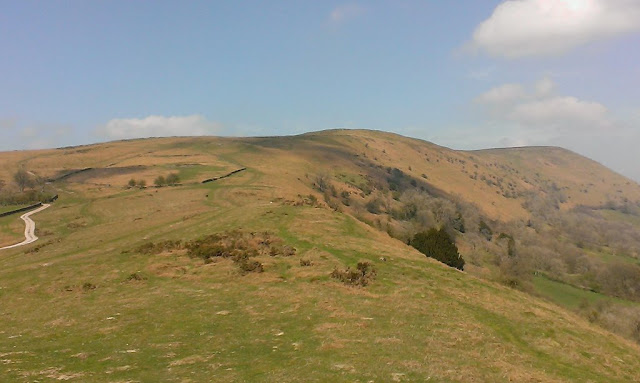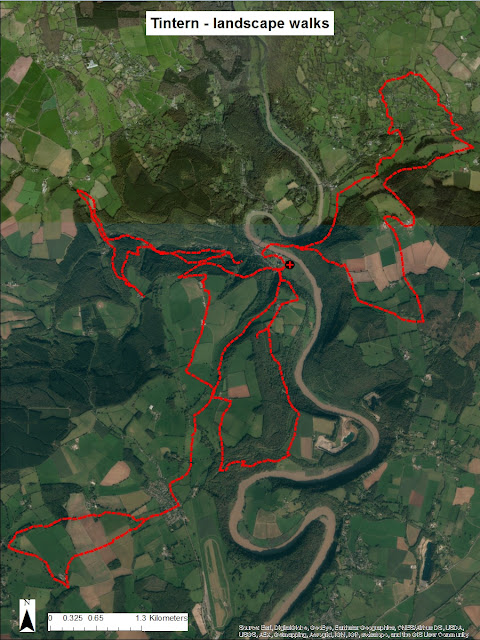The walk commences at the church of St. Michael’s in Llantarnam village at the southern limits of the new town, taking in the cul-de-sac lane opposite running parallel with a silted-up ditch draining into a culvert under the main road. This ditch forms part of a system of leats which fed the now demolished corn mill in the village and likely date to the monastic period.
From here a long straight stretch of Llantarnam Road is followed, leading directly from the old lane to the abbey into the centre of Cwmbran. This road follows the line of the route between the abbey and its granges and manorial lands to the north and also forms the start of the pilgrimage way from Llantarnam to the shrine at Penrhys further to the west in the Rhondda valley. Now a main route into the town, this old road is utterly suburban, lined by ribbon development, a mix of some larger Victorian and Edwardian houses, unremarkable housing stock from this period and the mid-twentieth century, and modern day additions.
The mill leat
opposite the church (Source: author).
Llantarnam Road
looking north-west (Source: author).
Part-way along the road the memory of the abbey's Scybor Court grange (latterly Court Farm) rises. The school built on the site of the demolished farm during the development of the new town in the 1960s has now itself been replaced by a housing estate, ‘St. Michael’s Gate’ (this name a reference to the local church but perhaps a missed opportunity to remember the medieval grange). Further along the road, the grange is memorialised in the 1950s council housing of the ‘Court Farm Estate’, including Court Farm Close and Court Farm Road (is this association with social housing the rationale for the new estate utilising a different name?). Further progress along the road brings more nomenclature linking the area to the abbey: Llantarnam Dental Practice, Llantarnam Primary School, Court Road Industrial Estate etc.
The land farmed by the medieval grange here is uniformly flat, forming the broad flood-plain of the Afon Lwyd a few hundred metres to the east. The old flood meadows of the grange that have not been concreted over form one of the recreational areas created as part of the planned new town, now the site of a large boating and fishing lake and a golf course.
Court Farm Close, part of the 1950s estate built
on the agricultural land of the monastic grange of Scybor Court (Source:
author).
New town roundabout looking north with entrance
to Court Road Industrial Estate to right (Source: author).
Remnant field at boundary of Scybor Court and
Gelli-las granges (Source: author).
Grange Road (Source: author).
The old track up to Gelli-las (still called Grange Road) is passed, now a residential street and service road for a supermarket and industrial units. Approaching the centre of Old Cwmbran, the small industrial settlement that preceded the new town and the housing stock becomes a mix of mid-nineteenth century cottages and late century worker’s terraces; the area now somewhat down at heal.
As the post-war trunk road into the centre of the town is bridged the old road curves westwards and climbs up the small hillock on which the medieval chapel of St. Dial’s, a stopping place on the pilgrimage route to Penrhys, stood. As the hill is climbed the character of the route changes, St. Dial’s Lane, bounded by an old wall and then hedge-lined, is now lined by fields: a rural snapshot amidst the urban new town. From a field containing a ruined barn, the site of Llanderfel pilgrimage chapel and the surrounding grange can be seen high on the side of Mynydd Maen looming in the distance to the west. This low river terrace hillock provides a prominent viewpoint and landmark in the landscape, probably explaining the location of the chapel here.
As the post-war trunk road into the centre of the town is bridged the old road curves westwards and climbs up the small hillock on which the medieval chapel of St. Dial’s, a stopping place on the pilgrimage route to Penrhys, stood. As the hill is climbed the character of the route changes, St. Dial’s Lane, bounded by an old wall and then hedge-lined, is now lined by fields: a rural snapshot amidst the urban new town. From a field containing a ruined barn, the site of Llanderfel pilgrimage chapel and the surrounding grange can be seen high on the side of Mynydd Maen looming in the distance to the west. This low river terrace hillock provides a prominent viewpoint and landmark in the landscape, probably explaining the location of the chapel here.
Section of old wall on lane up to St. Dial’s
(Source: author).
The rural character
of St. Dial’s Lane (Source: author).
Looking west towards the uplands of Mynydd Maen
towards the site of Llanderfel chapel on the distant hillside (Source: author).
Central Cwmbran on
the site of the Gelli-las grange (Source: author).
The site of St. Dial's House - and probably the medieval chapel - looking southwards (Source: author).
Descending from St. Dial’s, the lane runs alongside one of the modern roads through the new town to a roundabout. From here the line of the pilgrimage route continues westwards towards Llanderfel as a series of walking and cycle paths. This route will be picked up again later in the walk but now a diversion westwards through the remaining woodlands of the Freshwater suburb is followed. Here, remnant trees and dingles are intermixed with the housing of the new town, pathways running through the green spaces and linking residential areas with roads, schools and other infrastructure. The retention of significant woodland within the new town fabric is the result of a mix between idealism - the creation of the liveable, spacious neighbourhoods such as Fairwater and Greenmeadow with plenty of green areas – and pragmatism, with tree cover largely confined to the more difficult and marginal terrain alongside the courses of streams and steeper-sided gulleys.
St. Dial’s Lane beside the modern road through
the western suburbs of Cwmbran (Source: author).
The route of the pilgrimage way picked up again via
the footpath on the other side of the roundabout (Source: author).
Remnant woodland inter-mixed with new town
housing in the Freshwater area of Cwmbran (Source: author).
Housing in the
Greenmeadow area of Cwmbran (Source: author).
The old lane through Fairwater disappears into the
trees on the curve of this residential close (Source: author).
Bridge carrying the
lane, hidden away behind the suburban closes (Source: author).
The line of the pilgrim route from St. Dial’s to
Llanderfel, now a hollow line behind garden fences (Source: author).
A further section
of the track, preserved as a line of trees (Source: author).
A more well-defined
section of the track, lined by beech (Source: author).
Greenmeadow
community farm (Source: author).
Industrial pond
returned to nature, Forge Hammer (Source: author).
The Pontypool to
Newport canal looking southwards (Source: author).
Sports fields occupying some of the water
meadows of Gelli-las grange between the Afon Lwyd and the railway line (Source:
author).
Llantarnam Grange
Arts Centre (Source: author).








